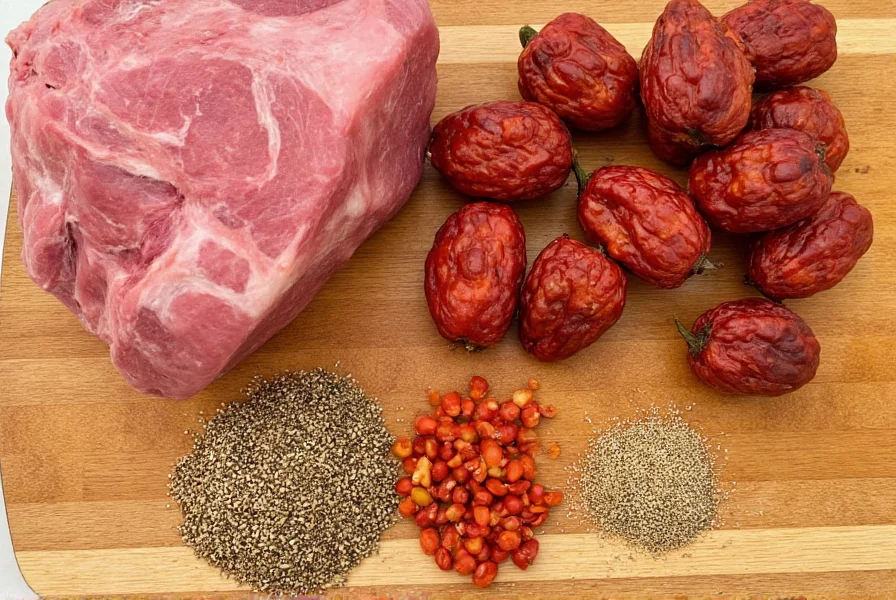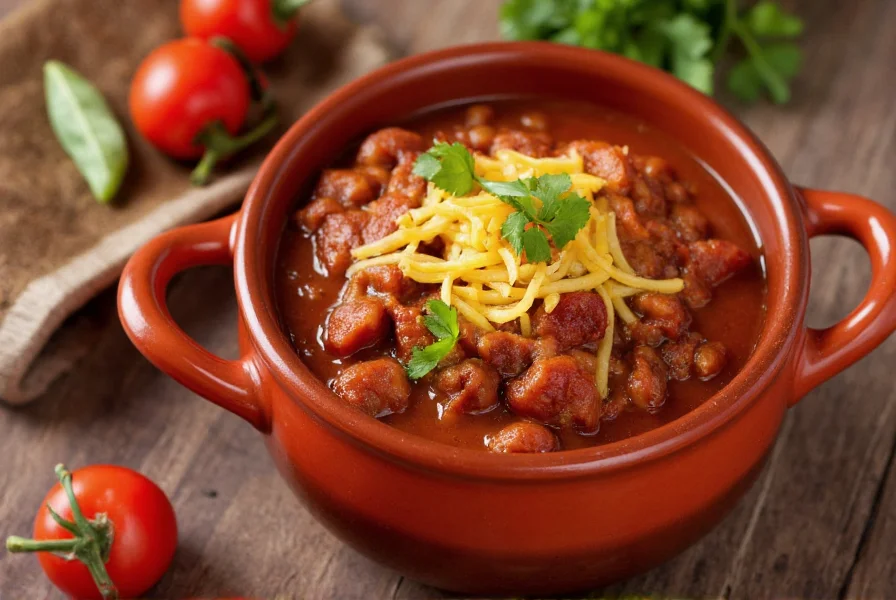For over a century, classic chili has represented the soul of Southwestern American cooking. This robust dish traces its roots to the cattle trails of 19th century Texas, where cowboys needed portable, protein-rich meals that could simmer for hours over open fires. Unlike modern adaptations, traditional Texas-style chili contains no beans—a point of pride among purists who consider beans an unnecessary addition that dilutes the rich meat and pepper flavors.
The True Essence of Classic Chili
Understanding what makes chili "classic" requires examining its historical context and essential components. Authentic Texas chili, often called "chili con carne" (chili with meat), emerged from the culinary traditions of Mexican vaqueros and Texas settlers. The dish evolved as a practical solution for preserving meat through slow cooking with available spices and peppers.
What sets classic chili apart from other variations? Three defining characteristics establish its authenticity:
| Characteristic | Classic Texas Chili | Common Variations |
|---|---|---|
| Beans | Never included | Often added (Midwest, California styles) |
| Meat Preparation | Cubed beef (not ground) | Ground beef common |
| Thickening Agent | Reduced meat juices | Tomato products, flour |
Essential Ingredients for Authentic Flavor
The magic of classic chili lies in its simplicity and quality of ingredients. Traditional recipes use surprisingly few components, allowing each element to shine through the slow cooking process.
Meat selection makes or breaks authentic chili. Purists prefer chuck roast cut into 1/2-inch cubes, which provides the perfect balance of lean meat and marbling. As the chili simmers, the connective tissues break down, creating a rich, velvety texture without needing thickeners. While ground beef works in a pinch, it lacks the textural complexity of cubed meat.
Dried chili peppers form the flavor foundation. Ancho, guajillo, and pasilla peppers provide distinct flavor profiles when rehydrated and pureed. Many home cooks mistakenly rely solely on chili powder, but authentic recipes start with whole dried peppers for superior depth of flavor. For a traditional Texas-style chili recipe, combine two parts ancho to one part each of guajillo and pasilla.
Spice balance separates good chili from exceptional chili. Cumin provides earthiness, but use it judiciously—too much overwhelms other flavors. Mexican oregano (different from Mediterranean oregano) adds floral notes, while a touch of cocoa powder deepens the overall flavor without adding sweetness. The secret ingredient many traditional cooks use? A small piece of dark chocolate added near the end of cooking.

Step-by-Step Classic Chili Preparation
Creating authentic classic chili requires patience and attention to detail. Follow these steps for traditional results:
- Prepare the chili paste: Toast dried peppers for 30 seconds per side, remove stems and seeds, then soak in hot water for 20 minutes. Blend with garlic, onion, and 1/2 cup soaking liquid until smooth.
- Sear the meat: Pat beef cubes dry and brown thoroughly in batches. This Maillard reaction creates complex flavors essential to great chili.
- Build flavor base: Sauté onions until caramelized, add chili paste and toast for 5 minutes to deepen flavors.
- Simmer slowly: Combine all ingredients and simmer uncovered for 2-3 hours until meat is tender and flavors meld. Stir occasionally and add water as needed to maintain consistency.
- Rest and serve: Let chili rest for at least 30 minutes before serving to allow flavors to fully integrate.
Avoiding Common Classic Chili Mistakes
Even experienced cooks make errors when preparing traditional chili. Understanding these pitfalls ensures authentic results:
- Using ground beef instead of cubed: While convenient, ground beef creates a different texture and releases too much fat during cooking
- Adding beans: Traditional Texas chili contains no beans—this is non-negotiable for authenticity
- Overusing tomato products: Authentic recipes use minimal or no tomatoes, relying instead on reduced meat juices for body
- Rushing the cooking process: Proper chili requires slow development of flavors—don't shorten the simmering time
- Skipping the resting period: Chili always tastes better after flavors have time to meld
Serving Classic Chili Traditionally
How you serve classic chili matters as much as how you make it. Traditional accompaniments enhance rather than compete with the chili's robust flavors:
- Oyster crackers: The classic topping that adds texture without overwhelming the chili
- Finely diced white onion: Provides a sharp contrast to the rich meat
- Lime wedges: A squeeze of fresh lime brightens the deep flavors
- Shredded cheddar cheese: Use sparingly—authentic Texas chili often skips cheese entirely
For a complete traditional meal, serve classic chili alongside cornbread—never with rice or spaghetti, which are characteristic of regional variations like Cincinnati chili.

Storage and Reheating for Maximum Flavor
Classic chili often tastes better the next day as flavors continue to develop. Proper storage maintains quality:
- Cool chili completely before refrigerating to prevent condensation
- Store in airtight containers for up to 4 days in the refrigerator
- Freeze portions for up to 3 months in freezer-safe containers
- Reheat gently on the stove with a splash of water or broth to restore consistency
Professional chili cooks know that reheating chili slowly over low heat preserves the delicate balance of flavors better than microwave reheating. The fat will rise to the top during storage—simply skim it off or stir it back in depending on your preference.
Frequently Asked Questions
Does authentic classic chili contain beans?
No, traditional Texas-style classic chili never includes beans. Beans represent a regional variation that developed later. Purists consider beans an inauthentic addition that dilutes the rich meat and pepper flavors that define true classic chili.
What's the difference between classic chili and Cincinnati chili?
Classic Texas chili features cubed beef, dried peppers, and spices without beans, served as a standalone dish. Cincinnati chili is a thinner, spiced meat sauce typically served over spaghetti with cheese, onions, or beans—a completely different preparation and serving style.
Can I make classic chili in a slow cooker?
Yes, but with modifications. Sear the meat and prepare the chili base on the stove first, then transfer to a slow cooker. Cook on low for 6-8 hours. Avoid cooking dried peppers directly in the slow cooker as the extended time can make them bitter.
How long should classic chili simmer for optimal flavor?
Authentic classic chili requires 2-3 hours of gentle simmering after the initial preparation. This allows connective tissues in the meat to break down properly and flavors to meld. Rushing this process results in less complex flavor development and tougher meat.
What cut of beef works best for classic chili?
Beef chuck roast cut into 1/2-inch cubes provides the ideal balance of lean meat and marbling. The connective tissue breaks down during slow cooking, creating a rich texture without needing thickeners. Avoid lean cuts like sirloin which become tough during extended cooking.











 浙公网安备
33010002000092号
浙公网安备
33010002000092号 浙B2-20120091-4
浙B2-20120091-4